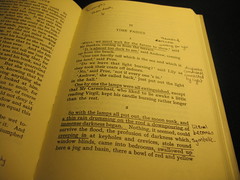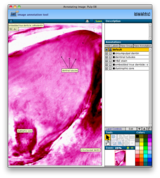Using Annotations for Close Reading Exercises
 A common student assignment is to summarize a text or other course material. The general approach to this type of assignment is to skim the material, look for indicators that might convey the author's intentions, and quote passages in a summarizing paper. However, we see faculty wanting students to move past reading-to-summarize. They want students to study course materials more actively, more analytically, believing that a more nuanced engagement with the content will lead to better learning outcomes. We sometimes describe this form of study as "close reading", and in some courses it constitutes a core learning activity.
A common student assignment is to summarize a text or other course material. The general approach to this type of assignment is to skim the material, look for indicators that might convey the author's intentions, and quote passages in a summarizing paper. However, we see faculty wanting students to move past reading-to-summarize. They want students to study course materials more actively, more analytically, believing that a more nuanced engagement with the content will lead to better learning outcomes. We sometimes describe this form of study as "close reading", and in some courses it constitutes a core learning activity.
Why close readings?
Close reading emphasizes a search for meaning within important microcosms of a piece, such as a specific sentence of a poem or pigment in a tapestry, as a path to understanding a macrocosm, such as an author's message, an historical event, or an entire culture. In the academy, those macrocosms could be the topic of a single lesson, a unit, or in some instances the subject of the course itself.
"Close reading" as an exercise usually applies to text, but includes other objects of communication, such as films, images or material objects. The "reading" of non-textual sources is accomplished in different ways, and new media technology has enabled their study to occur in ways that traditionally have been limited to text. Regardless of the medium, the basic premise behind analysis of this kind is that all objects of human creation carry layers of meaning, each open to discernment and interpretation if perceived and studied, and each adding to the educational value of studying the object (text or other) as a whole.
When students are given the task of close reading, they must decide what parts of an object are worthy of deeper study. This requires investigating early perceptions and scrutinizing possible significances. When they go on to research and describe interesting segments that they have identified, they begin to perceive significances that might otherwise have been hidden. As they test those perceived meanings against other observations, their engagement with the material increases and, in theory, the macrocosm comes into focus.
Challenges with Assigning Close Readings
Students are often inexperienced with the close reading technique, which differs markedly from the "skimming" technique that students may have practiced and honed over time.
Instructors, on the other hand, may struggle to effectively lead their students through the process of acquiring this new skill. Some of these obstacles to incorporating close reading into courses can be addressed with techniques for annotation as will be described below.
What is an Annotation?
Annotations can take a number of forms and serve a number of purposes. They might appear as descriptive labels attached to parts of images, handwritten notes in the margin of an undergraduate textbook, or sticky notes containing comments stuck to a presentation poster. They amount to descriptions of some thing, however small and fragmented from a whole, as interpreted by an observer. They can be created either for the benefit of the annotator as "notes to self", or serve as commentary for others, such as the editorial markings left by one student on the draft of a term paper for another.
Some would describe annotations as distinct from other forms of description because of their connectedness to the thing being described. For instance, an essay about a book exists separately from the book itself. Were someone to attempt to understand the essay in full, they would necessarily have to obtain a copy of the book, read it, and then attempt to connect the critic's thoughts and interpretations back to the source. An annotation, by contrast, exists upon the object being described. Its connectedness, or "embeddedness", allows the description to remain within the explicit context of the source. No reconnection needs to take place, and there is little room for doubt about what part of the object is being described, or its context.
Loosely defined, we can consider an annotation a form of commenting, something students do on their papers during editing or on their friends' blogs or Facebook pages in a social context. Bringing annotations into a course assignment engages students in the material by bringing familiar skills to unfamiliar topics.
Annotations Improve Student Engagement With Content
Annotations can improve student engagement with content in a few ways.
First, when students leave a comment on a specific word, sentence, or part of an object, their ideas or comments stay grounded in the object, preventing the description from shifting towards a student's prior knowledge, as is frequently seen when students quote text in a descriptive essay. Annotating text directly requires close attention to what the author has really said and the conversation remains grounded within the object being analyzed.
Second, students are led to consider carefully not just how they describe something, but prior to that, what should be described. This kind of descriptive decision making requires awareness of the whole, which often requires that students read the text more than once and necessitates an active, investigatory approach.
Third, when an annotation is left on a sentence/object that serves to challenge the author/creator, the student must read the surrounding lines and pages carefully to make sure that A) she understands the author's intent, B) she understands the context of the problematic sentence, and C) the author hasn't addressed her challenge elsewhere in the text, which would nullify the student's annotation.
Means of Effective Annotation
Annotations exist as a natural method of engagement with content, the most obvious example being the highlighted and marked lines of student textbooks--work that students do of their own accord, for themselves alone. Technology, however, has transformed the educational potential of annotations for teaching and learning. First, it enables the use of annotation to be applied to non-textual content. Second, it enables annotations to become more easily shared among students, and between students and instructors. Both have opened doors to new kinds of assignments, new dialogues among students and instructors, and improved and enhanced student projects.
There are three main media types that are amenable to technology-enhanced annotation.
Text
Text can be annotated in many ways, largely because the format varies so much in the digital arena:
- static documents such as PDFs and office documents can be annotated with notes using "track changes" features or via "sticky notes";
- collaborative, dynamic documents, as found in a wiki, can be annotated with text embedded within the original, perhaps given a different font type, and also with hyperlinks leading from the source text to descriptions, such as seen in this example wiki;
- textual discourse and conversation, such as threaded discussion and forum spaces, can be annotated by the addition of comments and posts.
Images
Using images as objects of study can be a powerful way of engaging students in course content. It is easy to imagine the benefits of annotating and describing parts of old maps in a history course, blueprints in an architecture course, or dig sites in an archeology course. Images can also be used to study larger phenomena--the macrocosms described earlier. For example, an ancient farming tool can become an important window into the culture and history of the people who used it when annotated and described with as much detail as possible. Evolving image annotation technologies can help students too:
- label parts of images with titles/names as a way of understanding a structure or constituency as might be found in a biology unit on cell structure, using tools like CCNMTL's IAT
- mark parts of images with brief or long descriptions of their meaning, or with questions about possible meanings as might be found in an art or material history courses, such done in the Engaging Digital Tibet project;
- inter-relate two elements to highlight similarities or differences in an image (or across images) in an ancient cultures course;
- cut and paste pieces of images for use in textual or multimedia arguments, strengthened by direct visual evidence of the thing being described.
Video
Video can be an important educational resource in a variety of courses, and this has been the case for decades. Until recently, however, use of video in education was limited to "read-only" activities. Various new technologies encourage more active engagement with video content, maximizing their educational value. Using annotations for teaching and learning from video can be considered a method of perception education: training a student eye to perceive like that of an expert. Assignments that require students to perform "close reading" by using annotations help students ''do something'' with content, allowing them to perform closer analysis and craft stronger arguments. Video annotation assignments also help faculty understand what their students are seeing and thinking as they study video, and enable them to better accomplish teaching objectives.
Video annotation can take a few different forms:
- "quoting" video by clipping it and using it within multimedia essays using tools such as CCNMTL's VITAL;
- taking a "director's pen" to clips of video, a-la John Madden, as might be found in a film class, using tools such as the web-based VoiceThread (http://voicethread.com);
- freezing a frame via screenshot for deeper analysis, and then annotating the frames as described above in images.
Using Annotation Assignments Effectively
CCNMTL has developed many techniques for interacting with course materials in ways that enrich the student experience, and improve and enhance learning. Annotation technology has been a major source of these enhancements to courses at Columbia. Over time, some key factors have emerged that lead to successful use of annotation assignments:
- If the goal is close reading, the more focused the assignment the better. It can sometimes be the case that having students spend four hours explicating a single paragraph will yield more important learning than if they were assigned the entire book.
- Faculty must frame the skill being developed (close reading/annotation) in a way that engages the students as active partners in knowledge development.
- Carefully consider the key teaching and learning objectives of the course and whether close reading is appropriate. If the goal is for students to get a general idea of a particular text or texts, then incorporating an annotation assignment might be the wrong way to go.




